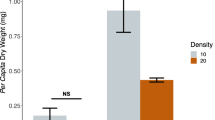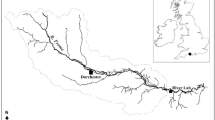Abstract
Fine particulate organic matter (FPOM) represents a major component of stream organic matter budgets, and its dynamics greatly affect the productivity and metabolism of a stream community. FPOM transport dynamics has been well documented in high-gradient streams with rocky substrates, but information from low-gradient, sandy-bottom streams has been lacking. We estimated FPOM retention patterns in Payne Creek, a 2nd order Coastal Plain stream (USA), under naturally varying hydraulic conditions (discharge and velocity). Corn pollen, as an FPOM analogue, was released along with a conservative solute tracer and the particle retention coefficient (k p) was calculated by fitting the ratio of total pollen remaining in the water column against the longitudinal transport distance to an exponential decay model. Pollen k p (n = 4) ranged from 0.034 to 0.214 /m, and particle transport distance (S p) ranged from 4.7 to 29.7 m. The S p measured in Payne Creek was in the lowest range of previously reported values, and such rapid particle retention was attributed to the low channel slope and slow current velocity. S p was significantly correlated to water velocity and the channel friction factor, but not to discharge (Q). Two summer experiments conducted in contiguous stream segments resulted in the shortest (4.7 m) and longest (29.7 m) S p, despite the similar Q. This was attributed to the segment-scale channel alterations that occurred during the previous winter, which led to very different hydraulic conditions in the two stream segments. In Payne Creek, seasonal changes in hydrology and segment-scale variation in channel morphology were the main factors controlling FPOM transport and retention.




Similar content being viewed by others
References
Allan JD, Castillo MM (2007) Stream ecology: structure and function of running waters. Springer, Dordrecht, The Netherlands
Bilby RE (1981) Role of organic debris dams in regulating the export of dissolved and particulate matter from a forested watershed. Ecology 62:1234–1243
Bilby RE, Likens GE (1979) Effect of hydrologic fluctuations on the transport of fine particulate organic carbon in a small stream. Limnol Oceanogr 24:69–75
Briggs MA, Gooseff MN, Peterson BJ, Morkeski K, Wollheim WM, Hopkinson CS (2010) Surface and hyporheic transient storage dynamics throughout a coastal stream network. Water Resour Res 46:W06516. doi:10.1029/2009WR008222
Broekhuizen N, Quinn JM (1998) Influence of stream size and catchment land-use on fine particulate organic matter retention in streams. NZ J Mar Freshwater Res 32:581–590
Cushing CE, Minshall GW, Newbold JD (1993) Transport dynamics of fine particulate organic matter in two Idaho streams. Limnol Oceanogr 38:1101–1115
D’Angelo DJ, Webster JR, Gregory SV, Meyer JL (1993) Transient storage in Appalachian and Cascade Mountain streams as related to hydraulic characteristics. J N Am Benthol Soc 12:223–235
Davis L (2007) Spatial patterns of geomorphic processes in channelized tributary streams. Phys Geogr 28:301–310. doi:10.2747/0272-3646.28.4.301
Felley JD (1992) Medium-low-gradient streams of the Gulf Coastal Plain. In: Hackney CT, Adams SM, Martin WH (eds) Biodiversity of the southeastern United States: aquatic communities. Wiley, New York, pp 233–269
Georgian T, Newbold JD, Thomas SA, Monaghan MT, Minshall GW, Cushing CE (2003) Comparison of corn pollen and natural fine particulate matter transport in streams: can pollen be used as a seston surrogate? J N Am Benthol Soc 22:2–16
Gordon ND, McMahon TA, Finlayson BL, Gippel CJ, Nathan RJ (2004) Stream hydrology: an introduction for ecologists. Wiley, Chichester, p 429
Hall RO, Peredney CL, Meyer JL (1996) The effect of invertebrate consumption on bacterial transport in a mountain stream. Limnol Oceanogr 41:1180–1187
Hart DR, Mulholland PJ, Marzolf ER, DeAngelis DL, Hendricks SP (1999) Relationships between hydraulic parameters in a small stream under varying flow and seasonal conditions. Hydrol Process 13:1497–1510
Harvey JW, Wagner BJ (2000) Quantifying hydrologic interactions between streams and their subsurface hyporheic zones. In: Jones JB, Mulholland PJ (eds) Streams and Ground Waters. Academic Press, New York, pp 3–44
Houser JN, Mullholland PJ, Manoley KO (2005) Catchment disturbance and stream metabolism: patterns in ecosystem respiration and gross primary production along a gradient of upland soil and vegetation disturbance. J N Am Benthol Soc 24:538–552
Huettel M, Ziebis W, Forster S (1996) Flow-induced uptake of particulate matter in permeable sediments. Limnol Oceanogr 41:309–322
Hünken A (2006) Resuspension of particulate organic matter in sand-bed lowland streams. Arch Hydrobiol 166:169–183
Hünken A, Mutz M (2007) Field studies on factors affecting very fine and ultra fine particulate organic matter deposition in low-gradient sand-bed streams. Hydrol Process 21:525–533
Jin H, Ward GM (2005) Hydraulic characteristics of a small Coastal Plain stream of the southeastern United States: effects of hydrology and season. Hydrol Process 19:4147–4160. doi:10.1002/hyp.5878
Jones JB, Smock LA (1991) Transport and retention of particulate organic matter in two low-gradient headwater streams. J N Am Benthol Soc 10:115–126
Karwan DL, Saiers JE (2009) Influences of seasonal flow regime on the fate and transport of fine particles and a dissolved solute in a New England stream. Water Resour Res 45:W11423. doi:10.1029/2009WR008077
Legrand-Marcq C, Laudelout H (1985) Longitudinal dispersion in forest stream. J Hydrol 78:317–324
McNair JN, Newbold JD, Hart DD (1997) Turbulent transport of suspended particles and dispersing benthic organisms: how long to hit the bottom? J Theor Biol 188:29–52
Metzler GM, Smock LA (1990) Storage and dynamics of subsurface detritus in sand bottomed stream. Can J Fish Aquat Sci 47:588–594
Meyer JL, Edwards RT (1990) Ecosystem metabolism and turnover of organic carbon along a blackwater river continuum. Ecology 71:668–677
Miller J, Georgian T (1992) Estimation of fine particle transport in streams using pollen as a seston analog. J N Am Benthol Soc 11:172–180
Minshall GW, Thomas SA, Newbold JD, Monaghan MT, Cushing CE (2000) Physical factors influencing fine organic particle transport and deposition in streams. J N Am Benthol Soc 19:1–16
Monaghan MT, Thomas SA, Minshall GW, Newbold JD, Cushing CE (2001) The influence of filter-feeding benthic macroinvertebrates on the transport and deposition of particulate organic matter and diatoms in two streams. Limnol Oceanogr 46:1091–1099
Morin A, Black C, Chalifour A, Boisvert J, Peters RH (1988) Effect of black fly ingestion and assimilation on seston transport in a Quebec lake outlet. Can J Fish Aquat Sci 45:705–714
Morrice JA, Valett HM, Dahm CN, Campana ME (1997) Alluvial characteristics, groundwater-surface water exchange and hydrological retention in headwater streams. Hydrol Process 11:253–267
Newbold JD, Thomas SA, Minshall GW, Cushing CE, Georgian T (2005) Deposition, benthic residence, and resuspension of fine organic particles in a mountain stream. Limnol Oceanogr 50:1571–1580
Packman AI, MacKay JS (2003) Interplay of stream-subsurface exchange, clay particle deposition, and streambed evolution. Water Resour Res 39:1097. doi:10.1029/2002WR001432
Paul MJ, Hall RO (2002) Particle transport and transient storage along a stream-size gradient in the Hubbard Brook Experimental Forest. J N Am Benthol Soc 21:195–206
Reynolds CS, White ML, Clarke RT, Marker AF (1990) Suspension and settlement of particles in flowing water: comparison of the effects of varying water depth and velocity in circulating channels. Freshwater Biol 24:23–34
Richardson DC, Kaplan LA, Newbold JD, Aufdenkampe AK (2009) Temporal dynamics of seston: a recurring nighttime peak and seasonal shifts in composition in a stream ecosystem. Limnol Oceanogr 54:344–354
Runkel RL (1998) One-dimensional transport with inflow and storage (OTIS): A solute transport model for streams and rivers. US Geological Survey Water-Resources Investigations Report 98-4018, US Geological survey: Denver, Colorado; 73. (Available from: http://co.water.usgs.gov/otis)
Runkel RL (2002) A new metric for determining the importance of transient storage. J N Am Benthol Soc 21:529–543
Shankman D (1993) Channel migration and vegetation patterns in the southeastern Coastal Plain. Conserv Biol 7:176–183
Shankman D, Smith LJ (2004) Stream channelization and swamp formation in the US Coastal Plain. Phys Geogr 25:22–38
Smock LA, Gillinsky E (1992) Coastal Plain blackwater streams. In: Hackney CT, Adams SM, Martin WH (eds) Biodiversity of the southeastern United States: aquatic communities. Wiley, New York, pp 271–313
Stofleth JM, Shields FD, Fox GA (2008) Hyporheic and total transient storage in small, sand-bed streams. Hydrol Process 22:1885–1894. doi:10.1002/hyp.6773
Stream Solute Workshop (1990) Concepts and methods for assessing solute dynamics in stream ecosystems. J N Am Benthol Soc 9:95–119
Thomas SA, Newbold JD, Monaghan MT, Minshall GW, Georgian T, Cushing CE (2001) The influence of particle size on the deposition of seston in streams. Limnol Oceanogr 46:1415–1424
Valett HM, Morrice JA, Dahm CN, Campana ME (1996) Parent lithology, surface-groundwater exchange, and nitrate retention in headwater streams. Limnol Oceanogr 41:333–345
Wagner BJ, Harvey JW (1997) Experimental design for estimating parameters of rate-limited mass transfer: analysis of stream tracer studies. Water Resour Res 33:1731–1741
Wallace JB, Webster JR, Meyer JL (1995) Influence of log additions on physical and biotic characteristics of a mountain stream. Can J Fish Aquat Sci 52:2120–2137
Wanner SC, Pusch M (2000) Use of fluorescently labeled Lycopodium spores as a tracer for suspended particles in a lowland river. J N Am Benthol Soc 19:648–658
Wanner SC, Pusch M (2001) Analysis of particulate organic matter retention by benthic structural elements in a lowland river (River Spree, Germany). Arch Hydrobiol 151:475–492
Ward GM, Ward AK, Dahm CN, Aumen NG (1994) Origin and formation of organic and inorganic particles in aquatic systems. In: Wotton RS (ed) The biology of particles in aquatic systems. CRC Press, Boca Raton, pp 45–73
Warren LL, Wotton RS, Wharton G, Bass JAB, Cotton JA (2009) The transport of fine particulate organic matter in vegetated chalk streams. Ecohydrology 2:480–491
Webster JR, Meyer JL (1997) Stream organic matter budgets. J N Am Benthol Soc 16:3–161
Webster JR, Benfield EF, Golladay SW, Hill BH, Hornick LE, Kazmierczak RF, Perry WB (1987) Experimental studies of physical factors affecting seston transport in streams. Limnol Oceanogr 32:848–863
Webster JR, Benfield EF, Ehrman TP, Schaeffer MA, Tank JL, Hutchens JJ, D’Angelo DJ (1999) What happens to allochthonous material that falls into streams? A synthesis of new and published information from Coweeta. Freshwater Biol 41:687–705
Acknowledgments
Mark Dedmon helped with field sampling and laboratory processing. This research was partially supported by the National Science Foundation, EPSCoR grant (OSR 91-08761). HJ was partially supported by the NSF Biocomplexity grant (EAR-0083752) and the Center for Freshwater Studies with funding from the Office of Academic Affairs of the University of Alabama. Thanks to Alfred Wüest, Margaret Carreiro, Chris Barton and three anonymous reviewers for their constructive comments on this manuscript.
Author information
Authors and Affiliations
Corresponding author
Rights and permissions
About this article
Cite this article
Jin, H., Ward, G.M. Fine particulate organic matter transport dynamics in a small Coastal Plain stream: influence of hydrology and channel morphology. Aquat Sci 75, 483–492 (2013). https://doi.org/10.1007/s00027-013-0294-7
Received:
Accepted:
Published:
Issue Date:
DOI: https://doi.org/10.1007/s00027-013-0294-7




